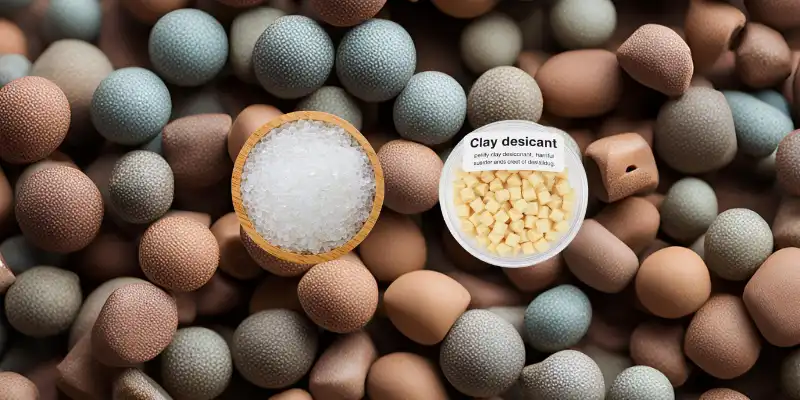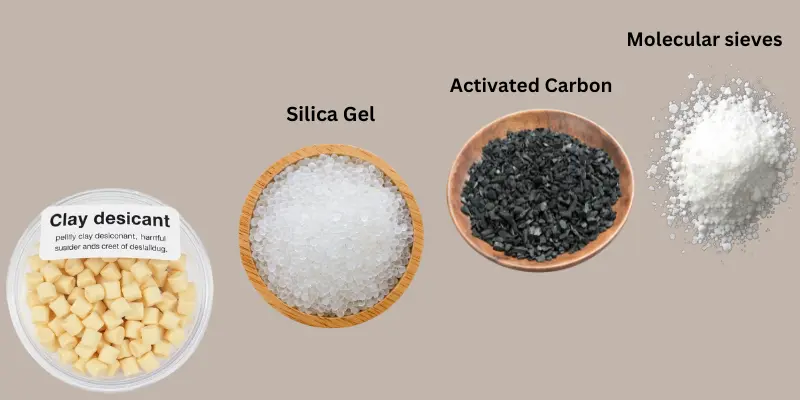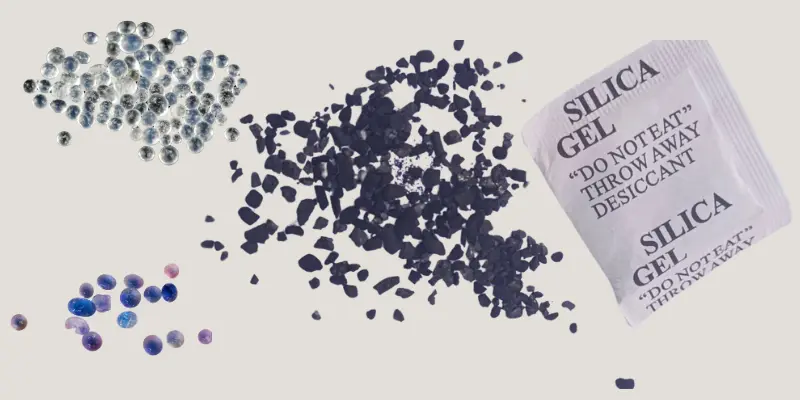What is desiccant? Keep Your Items Safe from Moisture Today!
Published: 2 Feb 2025
Hello, Earth Caretakers!
Do you know what those tiny packets in snack boxes or seed storage containers are for? They’re desiccants—materials that absorb moisture to keep items dry and safe. Examples include silica gel and calcium chloride, which protect seeds, food, and electronics from humidity and damage.
I’m Sheila, a botany enthusiast with seven years of research experience, and I’m here to simplify this topic for you. In this article, I’ll explain what desiccant is, how it works, its types, and where they’re used.

By the end, you’ll see how these little moisture-absorbing wonders can make a big difference in everyday life.
Let’s move forward!
What is Desiccant?
- A desiccant is a material that absorbs moisture from the air to keep things dry. Imagine you’re trying to store something precious, like an old book or an electronic gadget. If the air around it is too humid, the moisture could cause damage. This is where desiccants come into play—they act like little moisture magnets, helping to protect your items from dampness and mould.
- Over the years, I’ve seen how effective desiccants are in my work, especially when dealing with delicate botanical specimens. During my research in the School of Biological Sciences at Punjab University, we used desiccants to preserve plant samples. This made me realize how vital desiccants are—for plants and countless products, ranging from foods to electronics.
How Do Desiccants Work?
Desiccants absorb or adsorb moisture from the surrounding environment, keeping things dry and safe from damage. Think of a desiccant as a sponge for the air—it pulls in moisture to protect sensitive items, just like a sponge soaks up water.
There are two main ways desiccants achieve this:
- Absorption
- Adsorption
Absorption starts when moisture is drawn into the desiccant and becomes part of its structure. Silica gel is a good example, as it absorbs water molecules into its tiny pores, much like a sponge soaking up liquid.
Adsorption occurs when moisture sticks to the surface of the desiccant without being absorbed into its structure. A common example is activated carbon, which has a large surface area that holds moisture and odours.
In my botanical studies, I learned that the choice of desiccant depends on moisture levels and item sensitivity. For plant preservation, silica gel absorbed moisture without damaging delicate specimens.
Moisture Control Mechanisms
- Desiccants work by pulling moisture from the air due to a humidity gradient. Water molecules are attracted to the desiccant’s surface, where they can either bind to the surface (adsorption) or be absorbed into the material (absorption).
- Silica gel traps moisture in its tiny pores, while molecular sieves target specific moisture types with even smaller pores, making them ideal for specialized uses.
- With its porous structure, activated carbon absorbs moisture and odours, making it effective for packaging products that require dryness and odour control.
Common Types of Desiccants
Desiccants come in many forms, each tailored for specific industry moisture control needs. The choice of desiccant depends on the level of moisture, the environment, and the type of product being protected.

So, friends, let’s take a look at some of the most common types:
| Desiccant Type | Chemical Formula | Properties and Applications | Examples of Use |
| Silica gel | SiO₂ (Silicon Dioxide) | Silica gel consists of porous silica that absorbs moisture, keeping items dry. It is widely used for moisture control in packaging and preservation. | Used in electronics, shoes, medicine bottles, and botanical specimen storage. |
| Clay desiccants | Al₂O₃·SiO₂ (Aluminum Silicate) | Made from natural clay, these desiccants are effective for larger storage areas but less efficient than silica gel. They absorb moisture, reducing humidity. | Used in bulk storage, shipping containers, and long-term equipment storage. |
| Molecular sieves | (Na₂O·Al₂O₃)·nH₂O (Sodium Aluminosilicate) | Molecular sieves have uniform pores that target specific molecules, especially water, making them ideal for high-tech industries requiring precise moisture control. | Used in laboratories, electronics, and specialized moisture-sensitive environments. |
| Activated Carbon | C (Carbon) | Activated carbon has a porous structure that absorbs moisture and odours, making it effective for keeping products dry and odour-free. | Used in packaging for food, electronics, clothing, and dried plant storage. |
Silica Gel Bags
Silica gel bags are among the most popular moisture-absorbing solutions across various industries. They contain tiny beads of silica gel that absorb excess moisture from the surrounding environment. Silica gel bags are commonly found in packaging to protect products from humidity damage.

Advantages of Using Desiccants
- Cost-effective: An affordable solution for moisture control in various applications, from seed storage to electronics.
- Personal Experience: I’ve used silica gel packets for years to keep seeds viable and dry—an inexpensive yet effective choice.
- Easy to use: Simple to apply with pre-packaged options; place in the desired area or container.
- Personal Experience: I often use them to store garden tools, ensuring everything stays moisture-free with minimal effort.
- Widely available: Found in stores and online, making desiccants accessible for anyone, from beginners to professionals.
- Personal Experience: They’re a staple I always recommend to fellow gardeners for simple moisture protection.
Early History of Desiccant
- Desiccants have a long history, dating back to ancient times. Early civilizations like the Egyptians used salt and soda to preserve food and mummify bodies, while the Greeks and Romans used lime for drying and preserving items.
- The modern use of desiccants began in 1918 when Walter A. Patrick created silica gel, a material with exceptional moisture-absorbing properties. This innovation led to the widespread use of silica gel in industries like pharmaceuticals and electronics.
- As technology advanced, molecular sieves and activated carbon were developed, offering more specialized moisture control for high-tech applications.
- Today, desiccants are widely used in electronics, pharmaceuticals, food packaging, and shipping, helping protect products from moisture damage and maintain quality.
| Trivia Facts |
|---|
|
Conclusion
So, guys, it’s time to wrap up. In this article, we’ve covered what a desiccant is in detail. We’ve explored the different types and their uses, from silica gel to activated carbon.
After working with desiccants in various applications, I suggest trying silica gel bags, especially for storing moisture-sensitive items like shoes and gadgets. It’s easy to use and highly effective.
Now that you know how desiccants can help, consider adding them to your storage routines and start protecting your belongings today!
Frequently Asked Questions
For more information, you can read the frequently asked questions discussed below:
A desiccant is a material that absorbs or adsorbs moisture from its surroundings. It helps keep products dry by reducing humidity. Common desiccants include silica gel, activated carbon, and clay desiccants.
Yes, many desiccants can be reused. For example, silica gel can be dried in the oven to remove the absorbed moisture and used again. However, some desiccants, like activated carbon, may lose effectiveness over time.
Silica gel is the best electronic choice because it absorbs moisture without harming the components. It is widely used to protect gadgets during storage and transportation. Keep silica gel packets inside your electronic device boxes for added protection.
The lifespan of a desiccant depends on its environment and how much moisture it absorbs. Some desiccants, like silica gel, can last several months or even years if properly stored and maintained. Reuse or replace them when they no longer seem effective.
Yes, desiccants can help reduce humidity in small, enclosed spaces. However, a dehumidifier is more effective for large rooms. Desiccants like silica gel or activated carbon are ideal for smaller spaces like closets, drawers, or boxes.
| Reference Sources |
|---|

- Be Respectful
- Stay Relevant
- Stay Positive
- True Feedback
- Encourage Discussion
- Avoid Spamming
- No Fake News
- Don't Copy-Paste
- No Personal Attacks

- Be Respectful
- Stay Relevant
- Stay Positive
- True Feedback
- Encourage Discussion
- Avoid Spamming
- No Fake News
- Don't Copy-Paste
- No Personal Attacks





